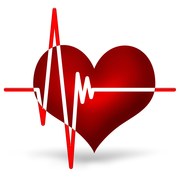 Zoya Fedorova/PhotoSpin
Zoya Fedorova/PhotoSpin
Skin and hair changes are common as we age. However, a recent 2012 study from Denmark has shown that those changes may also signal increased risk of heart disease or heart attack, especially if they seem to appear prematurely.
These visible signs of aging reflect aging of the organs inside our bodies. This is separate from showing our chronological age, Dr. Anne Tybjaerg-Hansen, lead investigator of the Copenhagen Heart Study and a professor of clinical biochemistry at the University of Copenhagen, indicated on Sciencedaily.com.
The study monitored four signs of aging:
- Receding hairline at the temples
- Baldness at the head's crown
- Earlobe crease
- Xanthelasmata (yellow fatty deposits around the eyelid)
Researchers found that the risk of heart attack for people who had three of these four signs increased by 57 percent, Medcitynews.com reported. Their risk for heart disease increased by 39 percent.
Almost 11,000 participants over the age of 40, were monitored for 35 years starting in 1976.
“Of them, 7,537 had receding hairlines at the temples, 3,938 had baldness at the crown of the head, 3,405 had earlobe crease and 678 sported fatty deposits around the eye, ” the article said.
Follow-up monitoring showed that 3,401 of those subjects developed heart disease and 1,708 suffered a heart attack.
The risk of heart disease or heart attack was still present after researchers statistically separated other risk factors such as elevated cholesterol, high blood pressure and smoking.
The limitation of this study is that only white subjects were tested, so results cannot be applied to other ethnic groups without further research. Results of this research were reported at the American Heart Association’s Scientific Sessions 2012.
This is not the first study that Dr. Anne Tybjaerg-Hansen has led to explore whether certain physical aging signs could indicate a risk of heart attack or heart disease.
In 2011, she reported study results of whether raised yellow patches of skin (xanthelasmata) around the upper or lower eyelids and white or grey rings around the cornea (arcus corneae) might be implicated as cardiac risk factors.
Researchers surveyed 12,745 individuals who had participated in the Copenhagen City Heart Study. These patients, aged 23 to 93, were also followed for over 30 years.
“The highest risks were found in men between the ages of 70 and 79. Those with xanthelasmata had a 53% increased risk compared to the 41% risk for men without the condition. The corresponding figures for women were 35% and 27%,” according to Sciencedaily.com.
Arcus cornea was not shown to be a significant independent risk predictor for heart attack or heart disease.
The take-away from both these studies is that these physical signs of aging can be indicators of cardiovascular risk. Researchers expressed that this knowledge can and should be used as a screening tool when doctors perform routine physical exams.
Sources:
Visible aging signs may predict heart disease. Reuters edition U.S. Web. 17 Feb. 2013.
http://www.reuters.com/article/2012/11/06/us-heart-aging-idUSBRE8A515M20...
Four visible aging signs may predict heart disease, including bald spots and earlobe creases. MedCityNews. Web. 17 Feb. 2013.
http://medcitynews.com/2012/11/four-visible-aging-signs-may-predict-hear...
American Heart Association. Telltale visible signs of aging may predict heart disease. ScienceDaily, 6 Nov. 2012. Web. 17 Feb. 2013.
http://www.sciencedaily.com/releases/2012/11/121106114221.htm
The visible signs of aging reflect physiologic or biologic age and are independent of chronologic age, ScienceDaily, 16 Sep. 2011. Web. 17 Feb. 2013.
http://www.sciencedaily.com/releases/2011/09/110915192438.htm
Michele is an R.N. freelance writer with a special interest in woman’s healthcare and quality of care issues. Other articles by Michele are at www.helium.com/users/487540/show_articles
Edited by Jody Smith




Add a Comment2 Comments
I don't know how old you are. Heart disease usually doesn't just appear so having your doctor monitor your lab work and blood pressure over time is important to catch any changes. Don't ignore symptoms that might indicate a problem such as breathing problems, swelling in your extremities or sensation of an irregular heart rate.
During your next physical exam discuss with your doctor that you understand a large study of over 30 years was done in Copenhagen that discussed these signs as being present in a significant number of those developing heart disease. See what he says and recommends to more closely monitor you.
thanks for your comment.
February 26, 2013 - 11:17amThis Comment
I have had all three symptoms and have had a heart scan and a full body scan and they found nothing wrong with my heart. is there other tests that would help conclude results in heart failure or heart attack?
February 26, 2013 - 10:48amThis Comment